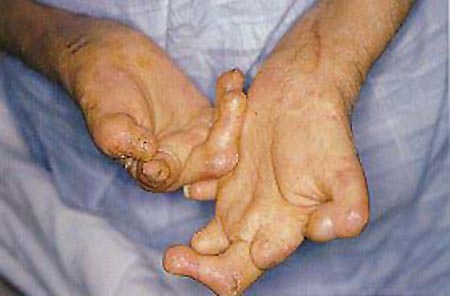
Treatment and further directions:
Pathology:
Because of the distinct lifecycle of M. leprae, leprosy takes a very long time to manifest itself as disease after infection (7). The incubation time alone can be up to 5 years for the pathogen (7)! It may even take up to 20 years for symptoms to appear (7). Once the disease has begun to manifest itself, leprosy is characterized by numbness in the extremities followed by chronic, escalating disfigurement depending on the rate of bacterial infection of the body. Specifically, leprosy can be divided into a number of categories based on the symptoms presented, and are treated differently as such.
Paucibacillary leprosy (associated with tuberculoid leprosy) is characterized by hypopigmented areas of the skin which have lost feeling (3, 4). Due to its association with tuberculoid leprosy (as opposed to lepromatous leprosy), it is possible that paucibacillary leprosy is not contagious (4).
Multibacillary lepsory is characterized by lesions on the skin, nodules, thickened skin, and damage to the nasal passages (3, 4). Serious multibacillary leprosy can lead to the loss of limbs – the loss of feeling prevents the adequate care of cuts or burns on extremities, which may lead to gangrenous infections and eventual amputation (4). Furthermore, serious leprosy of the nasal passages can cause loss of the nose or the eye (4). In some cases, severe infection may cause reduced output of testosterone from the testes, causing impotence and infertility in men (4).

Loss of digits due to multibacillary leprosy (link)
Prevalence:
In 2004, there were 410,000 new cases of leprosy (7). In developed nations, leprosy is not a significant problem; however, it is still a significant public health situation in a small number of countries in Africa, Asia, and Latin America (7). According to the WHO, five countries need significant assistance in controlling the prevalence of leprosy: Brazil, India, Madagascar, Mozambique, and Nepal (7). In fact, the CDC reports that these five countries account for roughly 902 of all leprosy cases (3).
Treatment:
Leprosy is treated with a multi-drug therapy of anti-mycotic antimicrobials (6). The WHO divides leprosy cases into three stages: ‘single-lesion paucibacillary’ (in which there is only one leprosy lesion visible), paucibacillary, or multibacillary (which is more advanced and where there are multiple lesions) (6). Single-lesion cases can be treated with only one dose of the multi-drug therapy; however, both of the other cases require months of treatment (6).
The WHO’s multi-drug therapy includes the drugs rifampicin and dapsone, with the inclusion of clofazimine for multibacillary cases (6). These drugs are put into ‘blister packs’, which make the drug easier to administer (6). Furthermore, this therapy has caused no resistance to develop, and is considered both safe and effective in treating leprosy (6).
One important note is that multi-drug therapy for leprosy is provided free by the WHO for anyone who requires therapy (7).
Rifampicin works by inhibiting the actions of bacterial RNA polymerase during bacterial peptide production in the cell (2). The rifampicin molecule binds close to the active site of the bacterial polymerase, preventing RNA elongation after 2-3 nucleotides (2). This way, the bacteria is inhibited from creating more bacterial particles in the cell and infection is stopped (2).
Dapsone works similar to sulfonamides, in that it inhibits the synthesis of dihydrofolic acid, a component of the bacterial cell wall (8). In higher doses, dapsone can also significantly reduce inflammation due to disease, although the mechanism of this action is not well understood (8).
However, there are a few drawbacks to the WHO’s drug therapy. First of all, the typical drug regimen suggested by the WHO can be very difficult to attain in developing countries – where leprosy is most prevalent (3).
Future directions:
One obvious goal for the future is the eradication of leprosy as a significant crippling disease in developing nations. It is certainly possible: the World Health Assembly of 1991 set its goal as eradicating any significant amount of leprosy in all of the countries of the Western Pacific region of the world – and had attained its goal in 35 or 37 countries by 2000 (5). For areas such as sub-Saharan Africa and South and Central America, the eradication of leprosy would be a significant attainment contributing to the health of the world.
Another goal is to culture M. leprae in vitro, which has so far proven impossible (1). In vitro culture of the mycobacterium would significantly help in the characterization of the bacteria and how it affects the human body, and would prove helpful in other mycobacterial infections, such as M. tuberculosis as well (1).
Sources:
1. Barker, L. 2006. Mycobacterium leprae interactions with the host cell: recent advances (Review article). Indian J Med Res, 123: 748-59.
2. Campbell, E. A., Korzheva, N., Mustaev, A., Murakami, K., Nair, S., Goldfarb, A., Darst, S. A. 2001. Structural Mechanisms for Rifampicin Inhibition of Bacterial RNA Polymerase. Cell. 104: 901-12.
3. “Hansen’s Disease: Leprosy”. Centers for Disease Control and Prevention: Division of Bacterial and Mycotic Diseases. Dept. of Human Health and Services. October 2005. link
4. “Leprosy”. The Merck Manuals: Online Medical Library. Merck 1 Co., Inc. February 2003. link
5. “Leprosy Elimination: Eliminating Leprosy”. World Health Organization Regional Office for the Western Pacific. 2005. link
6. “Leprosy Elimination: MDT Overview”. World Health Organization Regional Office for the Western Pacific. 2005. link
7. “Leprosy Fact Sheet”. World Health Organization. October 2005. link
8. Wolf, R., Matz, H., Orion, E., Tuzun, B., Tuzun, Y. 2002. Dapsone. Dermatology Online Journal. 8(1):2. link
Copyright Alex Greer 2007
For questions/comments, please contact Immunology professor Dr. Sofia Sarafova at Davidson College.